
Oil painting is the process of painting with pigments with a medium of drying oil as the binder. It has been the most common technique for artistic painting on wood panel or canvas for several centuries, spreading from Europe to the rest of the world. The advantages of oil for painting images include "greater flexibility, richer and denser colour, the use of layers, and a wider range from light to dark". But the process is slower, especially when one layer of paint needs to be allowed to dry before another is applied.

Gouache, body color, or opaque watercolor, is a water-medium paint consisting of natural pigment, water, a binding agent, and sometimes additional inert material. Gouache is designed to be opaque. Gouache has a considerable history, having been used for at least twelve centuries. It is used most consistently by commercial artists for posters, illustrations, comics, and other design work.

A toothbrush is an oral hygiene tool used to clean the teeth, gums, and tongue. It consists of a head of tightly clustered bristles, atop of which toothpaste can be applied, mounted on a handle which facilitates the cleaning of hard-to-reach areas of the mouth. They should be used in conjunction with something to clean between the teeth where the bristles of the toothbrush cannot reach - for example floss, tape or interdental brushes.

A brush is a common tool with bristles, wire or other filaments. It generally consists of a handle or block to which filaments are affixed in either a parallel or perpendicular orientation, depending on the way the brush is to be gripped during use. The material of both the block and bristles or filaments is chosen to withstand hazards of its intended use, such as corrosive chemicals, heat or abrasion. It is used for cleaning, grooming hair, make up, painting, surface finishing and for many other purposes. It is one of the most basic and versatile tools in use today, and the average household may contain several dozen varieties.
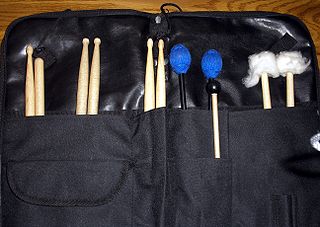
A percussion mallet or beater is an object used to strike or beat a percussion instrument in order to produce its sound.
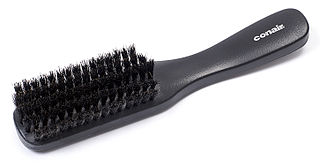
A hairbrush is a handle brush with rigid or soft spokes used in hair care for smoothing, styling, and detangling human hair, or for grooming an animal's fur. It can also be used for styling in combination with a curling iron or hair dryer.

Ink brushes are paintbrushes used in Chinese calligraphy as well as in Japanese, Korean and Vietnamese which both have roots in Chinese calligraphy. They are also used in Chinese painting and other brush painting styles. The ink brush was invented in China around 300 B.C. Together with the inkstone, inkstick and Xuan paper, these four writing implements form the Four Treasures of the Study.
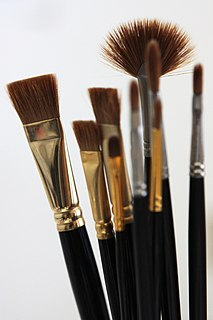
A kolinsky sable-hair brush is a fine artists' paintbrush.
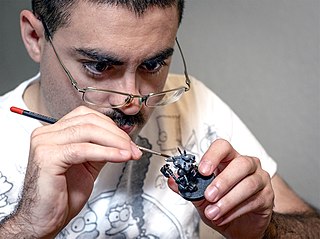
Figure painting, or miniature painting, is the hobby of painting miniature figures and/or model figures, either as a standalone activity or as a part of another activity that uses models, such as role-playing games, wargames, or military modeling.

Horsehair is the long hair growing on the manes and tails of horses. It is used for various purposes, including upholstery, brushes, the bows of musical instruments, a hard-wearing fabric called haircloth, and for horsehair plaster, a wallcovering material formerly used in the construction industry and now found only in older buildings.

A shaving brush or shave brush is a small brush with a handle parallel to the bristles used to make lather from shaving soap or shaving cream and apply it to the face when shaving. Shave brushes are often decorative; antique handles are often made from materials such as ivory or even gold, though the bristle load may be composed of any number of natural or synthetic materials. The shave brush is used most often today by "wet shavers" in tandem with a single- or double-edged safety razor or a straight razor. However, this is not always the case, as shavers of all varieties may employ the tool.
Winsor & Newton is an English manufacturing company based in London that produces a wide variety of fine art products, including acrylics, oils, watercolour, gouache, brushes, canvases, papers, inks, graphite and coloured pencils, markers, and charcoals.

Prolene is a synthetic, monofilament, nonabsorbable polypropylene suture. It is indicated for skin closure and general soft tissue approximation and ligation. Its advantages include minimal tissue reactivity and durability. Disadvantages include fragility, high plasticity, high expense, and difficulty of use compared to standard nylon sutures.

Animal fibers are natural fibers that consist largely of certain proteins. Examples include silk, hair/fur and feathers. The animal fibers used most commonly both in the manufacturing world as well as by the hand spinners are wool from domestic sheep and silk. Also very popular are alpaca fiber and mohair from Angora goats. Unusual fibers such as Angora wool from rabbits and Chiengora from dogs also exist, but are rarely used for mass production.
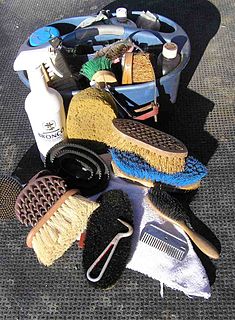
Horse grooming is hygienic care given to a horse, or a process by which the horse's physical appearance is enhanced for horse shows or other types of competition.
A pinstriping brush is the tool of traditional free hand pin stripers use for pin striping. Freehand pin striping is the most difficult method of pin striping and the brush is an important tool for design. Pinstriping brushes have several different designs: Swords, Daggers, and Flats, as well as Double line brushes. The brush consists of a small wood dowel handle, string or brass fixture with adhesive and brush hairs traditionally made from squirrel hair. The small wood dowel is balanced so pin stripers can freely spin the brush between their fingers. The dowel's short length is so the brush does not hit the palm of the hand while the brush is placed in-between the index finger and thumb. The hair of a pinstriping brush is relatively long at approximately 2 inches or more, compared to most artistic brushes of a similar size. This long length is to hold the necessary amount of paint to pull a long line.
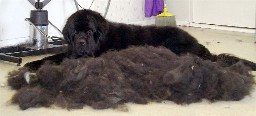
Dog grooming refers to both the hygienic care and cleaning of a dog, as well as a process by which a dog's physical appearance is enhanced for showing or other types of competition. A dog groomer is a person who earns their living grooming dogs.
Taklon is the common name for a synthetic fiber used in artist-quality paint, makeup and pin stripe brushes. It is a smooth, soft, and somewhat fragile polyester derivative devoid of any protein component or allergen elements and is therefore used in the cosmetic industries as a "green," "vegan," "allergy free" or synthetic alternative to animal hair brushes.

A makeup brush is a tool with bristles, used for the application of makeup or face painting. The bristles may be made out of natural or synthetic materials, while the handle is usually made out of plastic or wood. When cosmetics are applied using the appropriate brush, they blend better onto the skin.

A paintbrush is a brush used to apply paint or ink. A paintbrush is usually made by clamping bristles to a handle with a ferrule. They are available in various sizes, shapes, and materials. Thicker ones are used for filling in, and thinner ones are used for details. They may be subdivided into decorators' brushes used for painting and decorating and artists' brushes use for visual art.



















